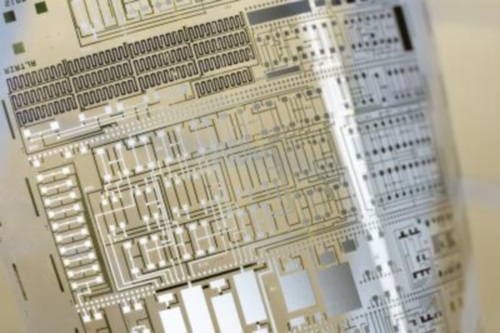Tons of food gets thrown away each year because the expiration date has passed. Researchers from Eindhoven University of Technology, Universitá di Catania, CEA-Liten, and STMicroelectronics got together to stop this problem, proposing a solution centered on a brand new invention: a plastic analog-digital converter (ADC).

A plastic analog-to-digital converter (ADC).
The technology was presented at the recent International Solid-State Circuits Conference (ISSCC) in San Francisco. While it is impressive to see a sensor circuit made of plastic, what’s even more noteworthy is the fact that it costs approximately one cent to manufacture. The circuit would be provided to producers to be included in their packaging to monitor the various levels of food that dictate freshness. This information could then be read using a scanner on a mobile phone to show the freshness of the food.
“In principle that's all already possible, using standard silicon ICs,” says researcher Eugenio Cantatore of Eindhoven University of Technology. “The only problem is they're too expensive. They easily cost ten cents. And that cost is too much for a one euro bag of crisps. We're now developing electronic devices that are made from plastic rather than silicon. The advantage is you can easily include these plastic sensors in plastic packaging.”
A typical sensor circuit consists of four components: sensor, amplifier, ADC, and radio transmitter. The missing component for the purpose of what the group is proposing here, has always been the plastic ADC.
“Now that we have all of the pieces, we need the integration,” says Cantatore.
Making the plastic ADC was no easy process: The electrical characteristics of normal transistors are highly predictable, but those of plastic transistors vary a great deal. “All plastic transistors behave differently in the low-cost production processes at low temperatures,” explains Cantatore. “That makes it much more difficult to use them in devices. You need complex mathematical models to be able to predict their behavior accurately.”
The final model the researchers came up with includes the following features: it offers a resolution of four bits, a speed of two hertz, and includes more than 100 n- and p-type transistors. A resistance level is on the sensor’s transparent plastic substrates and the carrier mobility of the printed transistors lies above the device’s amorphous silicon.
Looking ahead, Cantatore says that it will probably take at least five years before buyers can expect to see this technology at the supermarket. Beyond food store shelves, he foresees other potential applications for the technology in pharmaceuticals, man-machine interfaces, and in ambient intelligence systems for buildings and transportation.
Story via tue.nl.edu
Advertisement





